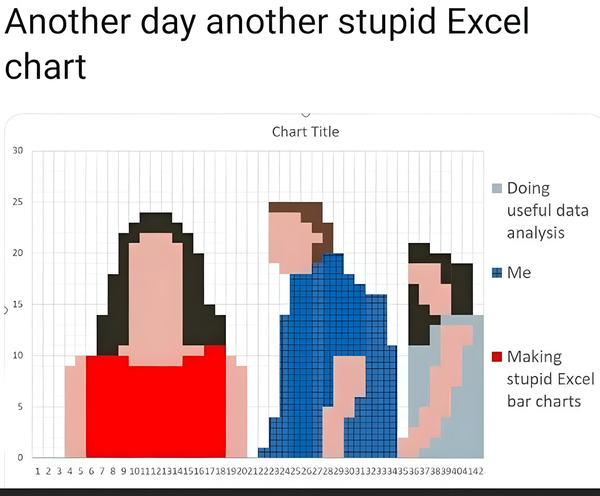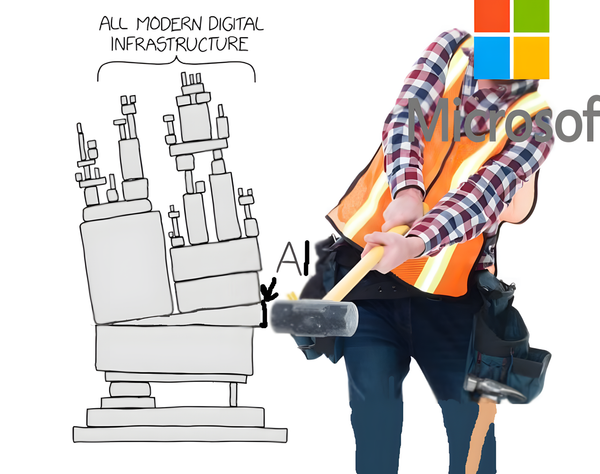The Managers' Guide #103

When standing as a group of people, always leave room for 1 person to join your group.
The Pac-Man Rule of Conferences
Ephemeral taskforce
- 🚀 Core Idea — Ephemeral taskforces are temporary, focused units bringing together diverse skills to solve a specific, critical problem, then disbanding — offering agility without permanent restructuring.
- 🎯 Key Advantage — They excel at tackling issues that are “urgent, important, but not clearly owned” by providing a dedicated, cross-functional effort that can bypass traditional silos and bureaucracy.
- 🛠️ Essential Components — Success hinges on a well-defined mission and clear success metrics, an empowered team (ideally volunteers with the necessary skills), a clear lifespan, and a dedicated lead to champion the effort and remove obstacles.
- ⚠️ Potential Challenges — Careful attention is needed to prevent scope creep, manage the dual responsibilities of team members (who often retain their “day jobs”), and ensure the taskforce truly remains “ephemeral” by disbanding as planned.
- 💡 Strategic Application — This model is particularly effective for exploring new opportunities quickly or resolving complex problems that don’t fit neatly within existing team structures — acting like a “special ops” or “tiger team” for businesses.
How tech workers really feel about work right now
- 🔥 Critical Burnout Levels — Nearly half (44.67%) of tech workers report significant burnout, which is strongly linked to career pessimism and intentions to quit — with founders and engineers experiencing less.
- 📉 Declining Optimism — While over half remain optimistic about their roles (58.5%) and careers (54.8%), there's been a notable negative shift in sentiment over the past year — though startup founders and new grads are bucking this trend.
- 🚀 Startup Founders Happiest — Founders consistently report the highest levels of optimism, job enjoyment, engagement, and belonging, along with the lowest burnout — being the only group growing more optimistic.
- 👎 Manager Effectiveness Gap — A large portion of tech workers (42.3%) view their managers as ineffective, and this rating strongly correlates with lower engagement, belonging, and job enjoyment, and higher burnout — highlighting a major area for improvement.
- 🏠 Work-Setup Nuances — While surface-level sentiment is similar across work setups, hybrid workers (mostly from home) feel “much better” about their current job, whereas in-office workers show slightly more optimism about long-term career prospects.
- 🏢 Small Companies Shine — Employees in smaller companies (especially 1-50 employees) report more positive sentiment across most metrics, including higher optimism, job enjoyment, engagement, and sense of belonging, plus lower burnout.
- 😟 The Mid-Career Slump — Professionals with 7-14 years of experience are struggling the most, reporting higher burnout, lower job enjoyment, and more pessimism — forming a U-shaped curve of sentiment across career stages.
- 🗺️ Career Clarity Gap — A significant number of tech workers lack clarity on the skills and development paths needed for their career goals, an uncertainty linked to lower engagement and likely contributing to career anxiety.
- ♀️ Gender Disparities — Women in the survey reported higher burnout and lower optimism than men (by ~3%), though interestingly, they also indicated higher engagement and a stronger sense of belonging.
- 🤖 AI Anxiety — The rise of AI is a notable concern, with the survey indicating that it’s “keeping tech workers up at night” — though further details were behind a paywall in the provided content.
Hitting OKRs vs. Doing Your Job
- 🤔 The OKR Dilemma — The article highlights a common tension: focusing intensely on hitting Objectives and Key Results (OKRs) can inadvertently lead to neglecting the essential, ongoing work of “doing your job”, which often involves reactive tasks, collaboration, and maintenance not easily captured by specific metrics.
- 🎯 OKRs for Change, Not Everything — OKRs are most effective when viewed as a tool for driving specific changes, improvements, or strategic initiatives, rather than an all-encompassing measure of an individual's or team's entire contribution or daily responsibilities.
- ⚖️ Distinguishing Work Types — A key learning is the importance of recognizing that “hitting OKRs” is distinct from the broader scope of “doing your job”. The latter includes crucial but less quantifiable activities like supporting colleagues, addressing emergent issues, and general system upkeep.
- 💡 Valuing Foundational Work — The piece underscores that the continuous effort of “keeping the lights on” — maintaining systems, supporting users, and ensuring smooth operations — is vital and must be valued, even if it doesn’t directly contribute to a specific OKR. This foundational work enables the pursuit of ambitious OKRs.
- 🗣️ Leadership’s Role in Clarity — It’s an interesting observation that leadership must clearly communicate how OKRs fit into the larger picture, ensuring they are seen as a supplement to core responsibilities and that employees aren't penalized for dedicating time to essential non-OKR tasks.
Systems Ideas That Sound Good (But Aren’t)
- 🛠️ Tooling Fallacy — An interesting observation is the common belief that simply adopting a new tool, methodology, or process (e.g., Agile, microservices) will magically solve underlying organizational or technical problems. The article suggests these often fail without addressing deeper issues.
- 📈 Metrics Over-Reliance — A key learning is that while metrics are useful, an over-reliance on them or poorly chosen metrics can lead to "gaming the system" or optimizing for the metric rather than the actual desired outcome — often distorting behavior.
- 🧩 Microservices Pitfall — The idea of breaking everything into microservices sounds good for scalability and independence, but often leads to significant operational complexity, distributed system challenges, and can be an over-engineering solution if the problem doesn't warrant it.
- ✨ "Rewrite Everything" Temptation — The desire for a "clean slate" rewrite is a common system idea that sounds appealing, but the article points out it often underestimates the complexity, loses embedded knowledge from the old system, and carries a high risk of failure or delayed delivery.
- 🤝 Centralized Decision-Making Misconception — While appearing efficient, trying to centralize all decisions or enforce a single “right way” for everything can stifle innovation, slow down teams, and fail to account for local context and expertise, which is a critical learning for large systems.
- 📜 Over-Prescriptive Processes — The idea that more detailed processes and stricter enforcement will lead to better outcomes is critiqued. The article suggests that overly rigid processes can hinder adaptability and problem-solving, especially in dynamic environments.
What Makes Strong Engineers Strong?
- 💡 Problem Solvers, Not Just Coders — A key learning is that strong engineers focus on solving the underlying problem effectively, rather than just implementing a given solution or writing code. They ask “why” and explore the problem space deeply.
- 🚀 Ownership and Initiative — Strong engineers take complete ownership of their work, from understanding requirements to ensuring successful deployment and operation. They don’t wait to be told what to do but proactively identify and tackle issues.
- 🤔 Critical Thinking and Skepticism — An interesting observation is that strong engineers apply critical thinking to requirements, designs, and even their own ideas. They are willing to question assumptions and push back respectfully if they foresee problems.
- 🌱 Continuous Learning and Adaptability — They possess a growth mindset, constantly seeking to learn new technologies, methodologies, and better ways of doing things. They are adaptable and can pick up new skills as needed.
- 🗣️ Effective Communication — A crucial point is that strong engineers can communicate complex technical ideas clearly to various audiences, including non-technical stakeholders. They are also good listeners and collaborators.
- 🔭 Systems Thinking — They understand how their work fits into the larger system and consider the broader implications of their decisions, including maintainability, scalability, and impact on other teams.
- 💪 Resilience and Pragmatism — Strong engineers are resilient in the face of setbacks and are pragmatic in their approach, understanding that perfect is often the enemy of good and knowing when to make trade-offs.
That’s all for this week’s edition
I hope you liked it, and you’ve learned something — if you did, don’t forget to give a thumbs-up, add your thoughts as comments, and share this issue with your friends and network.
See you all next week 👋



